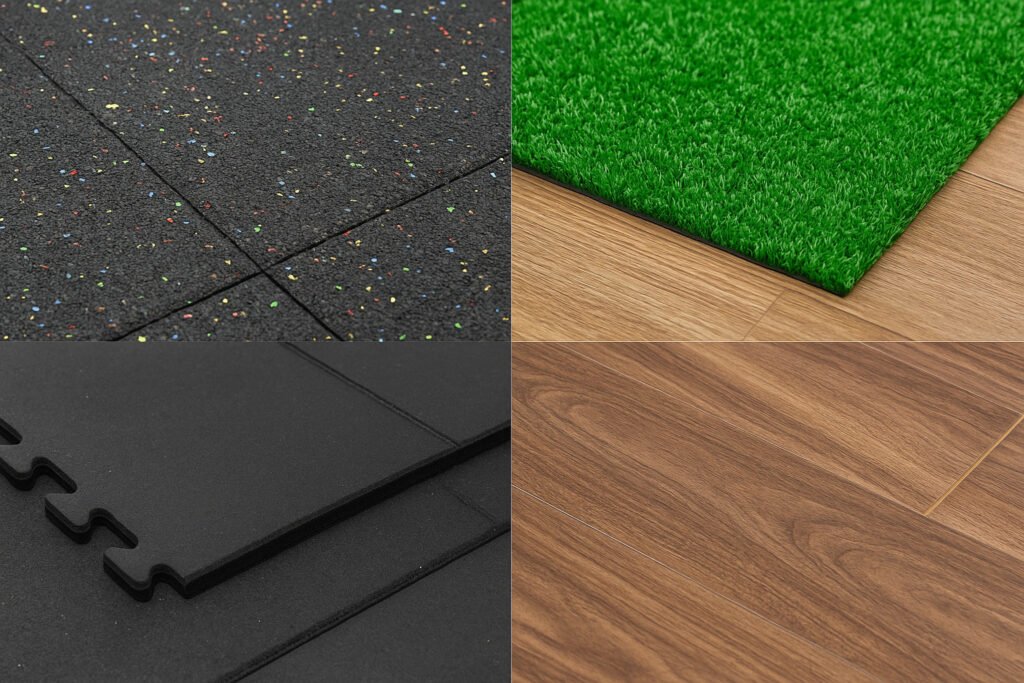What is the Best Material for Gym Flooring?
Choosing the best material for gym flooring is essential for safety, durability, and performance. Different training zones need different flooring materials. Some require high shock absorption, while others prioritize appearance or water resistance.
Rubber is the most recommended material for gym flooring due to its durability, shock absorption, anti-slip surface, and versatility across gym zones.

Rubber: The Most Versatile and Durable Material
Rubber flooring is used in nearly all commercial gyms because of its high performance across multiple zones.
- ✅ Types: Tiles, rolls, puzzle mats, and composite surfaces
- 📍 Best for: Weightlifting zones, cardio zones, stretching areas
- ⚙️ Features: Shock absorption, anti-slip, sound insulation, and easy cleaning
- 🔩 Recommended thickness: 6mm – 50mm based on zone
🔗 Products:
Foam: Lightweight but Limited
Foam flooring is lightweight, soft, and affordable, but it comes with performance limitations.
- ✅ Best for: Home gyms, light workouts, yoga rooms
- ❌ Not suitable for: Weight zones or high-traffic commercial gyms
- 📉 Cons: Easily compressed, poor durability, not impact-resistant
Vinyl: Decorative and Easy to Clean
Vinyl flooring is chosen for aesthetic zones like studios or front desks.
- ✅ Best for: Reception areas, yoga/pilates rooms, office spaces
- 🎨 Looks great with wood or clean surface finishes
- 💧 Waterproof and easy to sanitize
- ⚠️ Not ideal for heavy equipment or free weight drops
🔗 Related reading: Rubber vs. Vinyl Flooring
Turf: Best for Functional Training Zones
Artificial turf is widely used in CrossFit, HIIT, and functional training areas.
- ✅ Best for: Sled pushes, sprint lanes, agility training
- 📌 Often installed with rubber underlay
- 🔁 Indoor and outdoor applications
- 🟢 Adds variety and visual break to the gym layout
EPDM: The Best Material for Outdoor Gym Areas
EPDM rubber is weather-resistant and UV stable, making it perfect for outdoor use.
- ✅ Best for: Rooftop gyms, outdoor functional training, school fitness areas
- ☀️ Resists cracking, fading, and water pooling
- ⚒️ Installed as tiles or wet-pour systems
🔗 Explore: Outdoor Rubber Floor
Comparison Table
| Material | Durability | Shock Absorption | Slip Resistance | Ideal For |
|---|---|---|---|---|
| Rubber | ✅✅✅✅ | ✅✅✅✅ | ✅✅✅✅ | Commercial gyms, lifting |
| Foam | ❌ | ✅✅ | ✅✅ | Home gyms, yoga |
| Vinyl | ✅✅ | ❌ | ✅✅ | Studios, front desk |
| Turf | ✅✅✅ | ✅✅✅ | ✅✅✅ | Functional areas |
| EPDM | ✅✅✅✅ | ✅✅✅ | ✅✅✅✅ | Outdoor zones |
Related Blog Posts
- How to Choose the Best Rubber Flooring for Your Gym
- Rubber Tiles vs Rolls for Gym Flooring
- Best CrossFit Gym Flooring
- Rubber Flooring for Yoga Rooms and Office Spaces
Frequently Asked Questions
Q1: What is the best flooring for weightlifting areas?
A: Thick rubber tiles (20–50mm) offer top-level impact protection.
Q2: Is foam flooring good for commercial gyms?
A: No. Foam lacks durability and is not safe for weight zones.
Q3: Can I use vinyl flooring under gym equipment?
A: It’s not recommended. Vinyl is decorative and prone to denting under heavy weight.
Q4: Is turf safe for indoor use?
A: Yes. Turf is ideal for sled tracks and adds traction and visual contrast.
Q5: What material works best outdoors?
A: EPDM rubber offers the best weather resistance and safety for outdoor gyms.
Conclusion
Rubber remains the gold standard for commercial gyms, but combining materials—like turf for sleds or vinyl for offices—creates the best functional space.
Need help selecting the right material? Contact us or browse www.lanhefloor.com to learn more.
